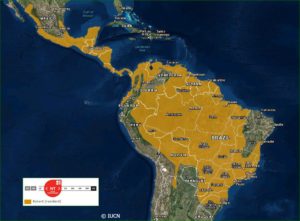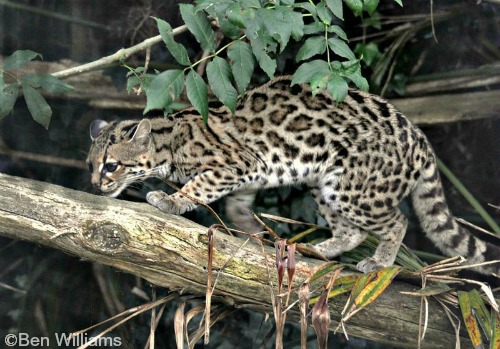- HB Length: 46-69 cm (18-27″)
- Tail Length: 23-52 cm (9-20″)
- Height: Appr. 30 cm (12″)
- Weight: 2.3-4.9 kg (5-11 lbs)
- Pop. Trend: Decreasing
Margays Leopardus wiedii are among the most beautiful and mysterious of the spotted cats in the Americas.
The Margay looks similar to the bigger Ocelot Leopardus pardalis and the smaller Tiger Cats Leopardus tigrinus/Leopardus guttulus which have similar coat patterns and colours. It is closer to the Tiger Cats in size but in appearance it resembles the Ocelot. In some parts of South America it is even called “little ocelot”.
Their coat is brownish yellow through tan, with black spots, stripes and blotches running lengthwise along their body. The Margay has a thick and soft fur, which renders one of its common names in northern Brazil, “gato-peludo” or “fury cat”. The centre of each spot, or rosette, is slightly paler, but still darker than the ground colour of the fur. The belly, chest, throat, chin, and insides of the legs are a snowy white. On the Margay, as on the Ocelot, the fur turns forward in the nape region, and the hairs on the neck are directed towards the crown. They have two dark cheek stripes on each side of the face. Their tail, as in many arboreal mammals, is very long, as much as 70% of the body length, and marked with broad rings, and a black tip. The backs of the large, rounded ears are black with a white central spot. Their eyes are enormous, and dark brown.
In 2018, researchers recorded the first instances of melanistic Margays, photographing one black individual in Columbia, and another in Costa Rica. Melanism is common for other members of the Leopardus genus, but had never been reported for the Margay.
Distribution

The Margay’s distribution range extends from central Mexico through Central and South America to Uruguay and northern Argentina.
Margays generally are uncommon to rare throughout their range, and only in very few areas can they be called relatively common. Generally population densities are between 1-5 individuals per 100 km². Only in a very few areas it seems to reach densities of up to 15-25 cats per 100 km².
A Brazilian radio telemetry study, maintained over 18 months, found home ranges to be 16 km². Researchers in the El Cielo Biosphere Reserve in northeastern Mexico trapped 15 individuals, indicating high Margay abundance. Four males in the study were found to have average home ranges of 4.03 km² and their ranges overlapped by 29%. The home range for one female was 0.96 km². Each cat maintained a core area that was about half the size of their home range. The apparently high numbers in the study area may be due to the absence of the Ocelot from this quality habitat.
Habitat
Compared to other tropical American cat species, the Margay is strongly associated with forest habitat and lives predominately in tropical and subtropical evergreen, deciduous/semi-deciduous, humid forests, and montane cloud forests. In open formations such as savannas and wet-swampy savannas it is usually found in gallery forests. Only occasionally it has been reported outside forested areas. Although they seem less tolerant to disturbance than other small wild cats, they use altered habitat such as disturbed forests, forest patches, agriculture/forest mosaics, or abandoned plantations only when sufficient tree cover is still available.
As a generalist carnivore and the largest and most adaptable of the small cat species in tropical America, the Ocelot dominates the other small cat species. In areas where the Ocelot occurs, species like the Margay avoid them because of the threat of predation, and prey competition. This negative effect on other small cat species is called the “ocelot effect”. When Ocelots inhabit protected areas, the smaller cats can be forced into adjacent unprotected areas, where the threat of habitat loss and human interaction is greater.
Ecology
Margays are the wizards of the tree tops, and are beautifully adapted to an arboreal habitat. One unique characteristic allows them to move and hunt more effectively in the trees. Their broad, soft feet and mobile toes allow them to hang from tree limbs by one hind foot, and flexible ankles can rotate the foot 180 degrees outward. They are exceedingly quick, and even during a fall they can grab hold of a branch with one front or hind paw and climb up again. Broad soft feet provide a good platform for jumping and an effective gripping surface for climbing.
Their exceptionally long, heavy tail aids in balancing while moving from tree to tree. In some areas, Margays hunt, sleep, and even have their young in trees. When they do descend, they walk slowly head first down the trunk, unlike most cats who rush down or descend hind feet first. Captive cats have been seen jumping nearly six metres straight in the air and nine metres horizontally.
Margays hunt mostly on the ground but also take prey in trees. Travelling is done mostly on the ground.
The Mexican study showed the highest activity levels between 1800 and 0400 hours, confirming the nocturnal habits of the Margay. They feed on both terrestrial and climbing small mammals, birds and reptiles. Medium sized mammals like squirrels, rabbits, agoutis, or small monkeys are also taken, but to a lesser extent. Typically small rodents form the bulk of the diet, but lizards and especially birds can comprise important items at some sites.
Their spectacular agility even allows them to capture small primates, a feat the larger Ocelot cannot manage. In 2005, primate scientists in the Amazon rain forest of Brazil heard a Margay imitating the call of a baby pied tamarin monkey. It was the first scientifically documented case of a cat imitating a prey species in the Americas. Though the high-pitched squeal was a “poor imitation” of a baby, it was similar enough to attract curious adult tamarins feeding nearby to come closer and investigate.
Reproduction
Margays are solitary except for a mother with kittens. After a gestation period of approximately 76 – 85 days, a single kitten, (rarely two), is born once a year. Unlike other wild cat species, Margays have only one pair of mammary glands, and can ovulate spontaneously. Birth weight is 84 – 170 grams, and their eyes open at about two weeks of age. The young are darker than the adults, and have uniformly dark spots and dark grey paws. Weaning takes place at around two months, and sexual maturity is reached at about two years. They have been known to live to 20 years of age in captivity.
Threats
- habitat fragmentation and destruction due to deforestation and conversion of forests into agricultural areas
- illegal hunting for their pelts
- killed by automobiles
- illegal trade for the pet market
- killing due to poultry depredation
- susceptible to disease outbreaks
- low reproductive rate
Conservation
The Margay is classified Near Threatened by the IUCN Red List and in Colombia. In Costa Rica and Mexico it is considered as Threatened, and in Argentina and Brazil as Vulnerable.
It is fully protected over most of its range. Hunting and trade are prohibited in Argentina, Bolivia, Brazil, Colombia, Costa Rica, French Guiana, Guatemala, Honduras, Mexico, Nicaragua, Panama, Paraguay, Peru, Suriname, Uruguay and Venezuela. In Ecuador, Guyana and El Salvador it is not legally protected.
Until trade restrictions in the late 1980’s, the Margay was one of the four most heavily exploited cats for the fur trade. In 1991, it was found that the Margay was still the most common pelt in the southern Mexico skin trade, despite its protected status.The combination of threats has virtually decimated wild populations of this beautiful little cat. They have never been common, and are rarer in general than the Ocelot, both in the wild and in captivity.
Very little is known of the status and abundance of the Margay. Populations in protected areas outside the Amazon basin are assumed to be very low and not viable in the long term, perhaps due to the Ocelot effect. The species could be classified as Vulnerable in the future, and periodical reviews are of high importance. Furthermore, more studies on the ecology, demographics, natural history, status and threats are needed to support adequate conservation efforts.
Compare these beautiful cats to the similar but larger Ocelot.
Range map IUCN Red List 2018
Updated 2018
José F. González-Maya, Andrés Arias-Alzate, Ramón Granados-Peña, Diego A.Gómez-Hoyos, Jan Schipper, Miguel Manjarrés-Morrón, Gustavo Manjarrés Pinzón – Rev.Mex.Biodivers. 89 (2018): 587-589


Pat Bumstead
All of our fact sheets are put together by a variety of staff. Our source information comes from The World Conservation Union Cat Specialist Group.
Leah H
Who is the author i’m understanding margays for an assignment.